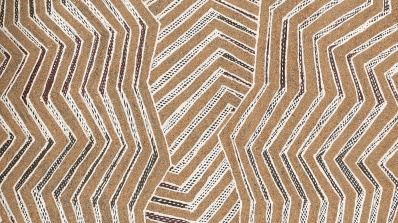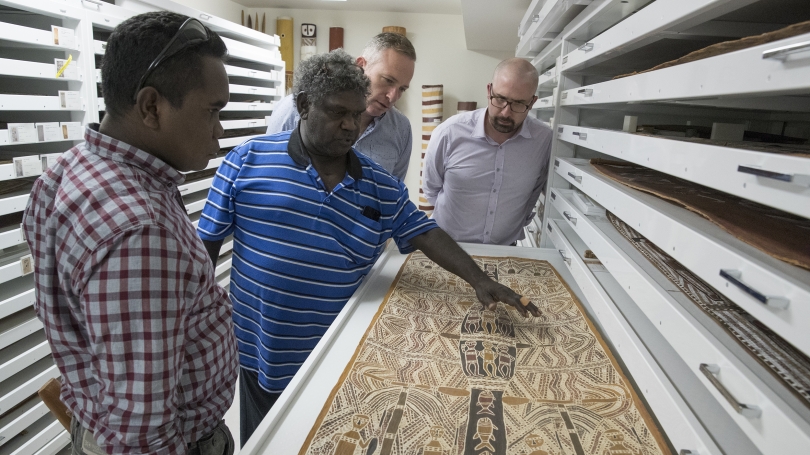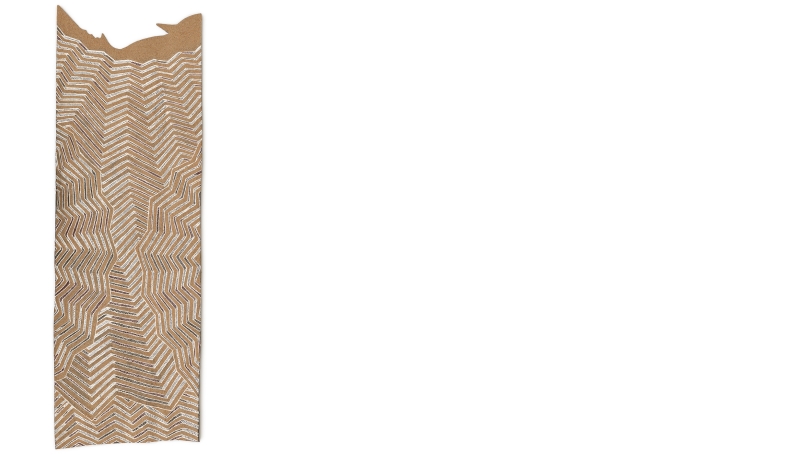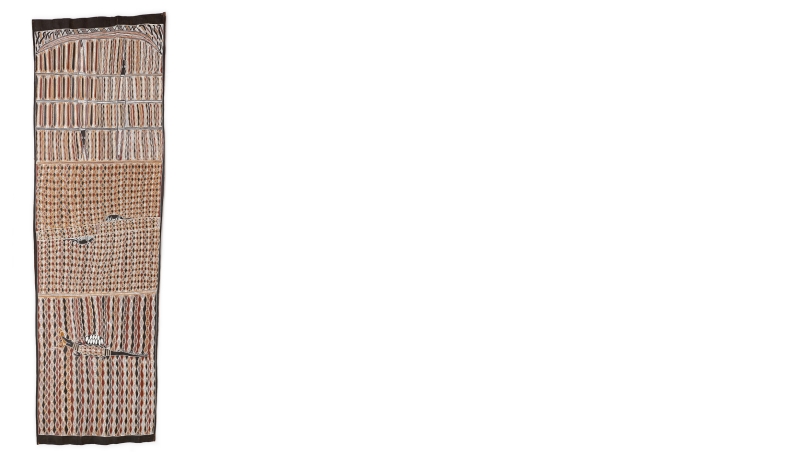"Maḏayin: Eight Decades of Aboriginal Australian Bark Painting from Yirrkala" Premieres at Hood Museum of Art in September 2022
First major exhibition of Aboriginal Australian bark paintings to tour the U.S.
The Hood Museum of Art, Dartmouth in Hanover, New Hampshire makes history this fall when it debuts Maḏayin: Eight Decades of Aboriginal Australian Bark Painting from Yirrkala, the first major exhibition of Aboriginal Australian bark paintings to tour the United States. On view from Sept. 3 through Dec. 4, 2022, Maḏayin presents an unbroken tradition representing a unique contribution to global contemporary art emanating from a remote corner of Australia from the perspective of those who shaped it.
Maḏayin: Eight Decades of Aboriginal Australian Bark Painting from Yirrkala was organized by the Kluge-Ruhe Aboriginal Art Collection of the University of Virginia in partnership with the Buku-Larrŋgay Mulka Centre in Australia. The Hood Museum also collaborated on the exhibition's content and presentation.
The largest and most important exhibition of Aboriginal Australian art mounted in the western hemisphere in over 30 years, Maḏayin will also reinforce the leading role of Indigenous artists in shaping global contemporary art.
"Maḏayin extends the Hood Museum's well-established commitment to Aboriginal Australian art," said John Stomberg, the Hood Museum's Virginia Rice Kelsey 1961s director. "These paintings represent an art movement unlike any other. This work, compelling and original, is thoroughly of one place: Yirrkala."
Vivid, intricate and mesmerizing, the paintings represent a contemporary interpretation of an ancient tradition of Indigenous knowledge expression. For millennia, Yolŋu around Yirrkala in northern Australia have painted their clan designs on their bodies and ceremonial objects. These designs are not merely decorative, they are the sacred patterns of the ancestral land itself. Yolŋu describe them as "maḏayin" — a term that encompasses both the sacred and the beautiful. Bark paintings are created using natural pigments on carefully prepared sheets of eucalyptus bark, with shimmering detail achieved using a fine paintbrush made of human hair. The organic irregularities of the medium give each work a dramatic sculptural presence, with some standing over 12 feet tall.
Adding to the historic nature of the exhibition, Maḏayin marks the first time that Yolŋu have been asked to participate fully in the decision-making processes of an exhibition. "I didn't know what a 'curating' job meant. It was the first time I had heard the word, and the first time it hit my mind, how to do the job of curating," said Mr. Waṉambi, artist and Yolŋu co-curator of Maḏayin with artwork on view in the exhibition. "No Yolŋu have done that job before, only balanda (non-Yolŋu) have done it, but in a different way because they have a different way of understanding."
Recognizing Indigenous authority and leadership, Maḏayin opens the door for Yolŋu Aboriginal Australian people to tell the story of their culture and heritage, creating a new model for curatorial partnership between Indigenous people and Western museums and opening the door for diverse and previously unheard voices in American museums.
"The land has everything it needs. But it couldn't speak. It couldn't express itself. Tell its identity. And so it grew a tongue. That is the Yolŋu. That is me. We are the tongue of the land. Grown by the land so it can sing who it is. We exist so we can paint the land," Djambawa Marawili, Yolŋu leader and artist, explained. The idea for the exhibition was born when Marawili found his clan designs on bark paintings in American museums during a residency at Kluge-Ruhe in 2015.
Energetic and spiritual, the paintings — some dating to 1935, others newly commissioned by Kluge-Ruhe from leading Yolŋu Aboriginal Australian artists specifically for this project — feature linear and geometric patterns interspersed with human figures and animals. Depictions of crocodiles, sharks and kangaroos help tell the story of the Yolŋu homelands and show the world a way of life in harmony with other people and the natural environment.
"We have a great culture and a great story to tell about living in a peaceful and humble and fruitful way on this country," Marawili said. "There are people who want to interrupt the country and destroy it through mining or by taking what belongs to other people, but we are here to represent the country. We live on the country and manage it. Our artworks represent the country and we can show the pattern, the story and songlines to prove we are from this country."
Visitors will be guided through the exhibition by a video of the Yolŋu curators which will introduce the major themes and ceremonially sing visitors into the exhibition. At four critical junctures, visitors will see floor-to-ceiling video projections of ceremonial dance produced by acclaimed Yolŋu filmmaker Ishmael Marika.
Maḏayin features more than 80 paintings from the Kluge-Ruhe Aboriginal Art Collection of the University of Virginia and other major museums and private collections in the United States and Australia including the National Gallery of Australia, Art Gallery of New South Wales, Museum and Gallery of the Northern Territory and the University of Melbourne; many of the artworks on view have never been seen previously in the U.S. The exhibition will be accompanied by a comprehensive 348-page bilingual catalog (in Yolŋu matha and English) distributed internationally by DelMonico Books D.A.P.
A celebration of the exhibition will take place Thursday, Sept. 22 through Saturday, Sept. 24, 2022. A range of public events are planned, including a ceremonial launching of the exhibition by a delegation of Yolŋu artists from Yirrkala. Click here for more information about the exhibition's opening events.
After its premiere at the Hood Museum of Art, Maḏayin: Eight Decades of Aboriginal Australian Bark Painting from Yirrkala will embark on a nationwide tour beginning with American University Museum at the Katzen Art Center, Washington, DC (January 28–May 21, 2023). It will then travel to the Carolyn Campagna Kleefeld Contemporary Art Museum at California State University, Long Beach (August–December 2023), the Fralin Museum of Art, University of Virginia, Charlottesville, Virginia (February 22–July 21, 2024), and the Asia Society Museum, New York (September 24, 2024–January 5, 2025).
The Kluge-Ruhe Aboriginal Art Collection of the University of Virginia is the only museum in the U.S. dedicated to the exhibition and study of Indigenous Australian art. As the foremost public collection of Aboriginal Australian art outside of Australia, the museum has collaborated on exhibition and education projects with public institutions across the world, including the National Museum of Women in the Arts, National Gallery of Australia, the Art Gallery of South Australia and Musée de la civilisation.
Maḏayin: Eight Decades of Aboriginal Australian Bark Painting from Yirrkala is organized by the Kluge-Ruhe Aboriginal Art Collection of the University of Virginia in partnership with the Buku- Larrŋgay Mulka Centre, Yirrkala. It is supported by the National Endowment for the Humanities, the Australian Government, the Andy Warhol Foundation for the Visual Arts, the Andrew W. Mellon Foundation and Crozier Fine Arts. Its presentation at the Hood Museum of Art, Dartmouth is generously supported by the Charles Gilman Family Endowment, the Owen and Wagner Collection of Aboriginal Australian Art Endowment Fund and the Jack and Dorothy Byrne Foundation. The exhibition has been made possible through the longstanding relationship between Kluge-Ruhe and the Yolŋu community at Yirrkala. More information about the exhibition can be found at madayin.kluge-ruhe.org.
About the Hood Museum of Art
The Hood Museum of Art, Dartmouth centers art and people in teaching and learning through inclusive and robust academic, cultural and civic engagements with art and its histories. It seeks to advance learning, care and connections through the reach and relevance of visual art and material culture as a nexus for the exchange of ideas. With its renewed focus on serving Dartmouth's faculty and academic mission, the recently expanded facility broadens the museum's reach to students, faculty and departments across campus, while deepening its engagement with its longtime stakeholders. It also makes a bolder statement about the significance of the arts within the life of Dartmouth and provides the arts district with an arresting front door to the Green.
About Dartmouth College
Dartmouth College educates the most promising students and prepares them for a lifetime of learning and of responsible leadership, through a faculty dedicated to teaching and the creation of knowledge. The Dartmouth model is unique in higher education: the fusion of a renowned liberal arts college and robust research university where students and faculty partner to take on the world's great challenges. Since its founding in 1769, Dartmouth has provided an intimate and inspirational setting where talented faculty, students and staff—diverse in background but united in purpose—contribute to the strength of an exciting academic community that cuts easily across disciplines.
About the Kluge-Ruhe Aboriginal Art Collection of the University of Virginia
The Kluge-Ruhe Aboriginal Art Collection expands knowledge and understanding of Indigenous Australian arts and cultures to cultivate greater appreciation of human diversity and creativity. With a collection of more than 2,200 objects, Kluge-Ruhe offers a variety of rich programming on-site and digitally. Its well-established residency programs bring eminent Indigenous artists and knowledge holders to Charlottesville to engage with the University of Virginia community and the public. Kluge-Ruhe is committed to expanding Indigenous leadership throughout the museum and creating high-value, immersive experiences to serve broader audiences.
Media contacts:
Stephanie Elton
Blue Water Communications
800.975.3213
elton@bluewatercommunications.biz
Nils Nadeau
Hood Museum of Art, Dartmouth
Associate Director, External Relations and Operations
603.646.2095
nils.a.nadeau@dartmouth.edu
Anna Kaye Schulte
Hood Museum of Art, Dartmouth
Public Relations Assistant
603.646.2821
anna.kaye.m.schulte@dartmouth.edu
Additional Information
Related Exhibitions
- Shifting the Lens
- A World of Relations
- Crossing Cultures: The Owen and Wagner Collection of Contemporary Aboriginal Australian Art at the Hood Museum of Art
- Dreaming Their Way: Australian Aboriginal Women Painters
- Dreaming of Country: Painting, Place, and People in Australia




